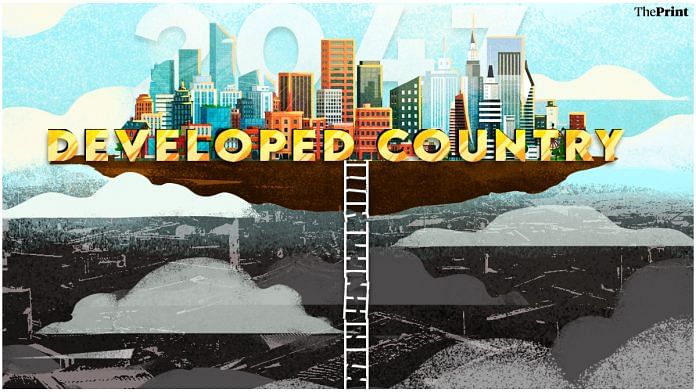The Narendra Modi government has set before the country the goal of attaining “developed country” status by 2047. On an initial reckoning, this seems a tall order, and one might justifiably wonder whether this is just another chimera — like doubling farmers’ incomes by 2022, or getting manufacturing to account for 25 per cent of GDP, also by 2022, or becoming a $5-trillion economy next year.
Besides, the government has not defined what being a “developed” country might mean, and there is no one international benchmark to apply.
However, various development indicators exist, focusing on income level, health and education standards, quality of life (e.g., access to electricity and safe drinking water), availability of work, levels of poverty and inequality, technological attainments, and so on. The starting assumption is the obvious one — that India is well short of the required levels on such indicators. So the goal set for the next quarter-century is ambitious, but what’s life without some ambition?
Getting there would, in fact, be momentous if one considered the arc from 1947 to 2047, and especially the scale.
Might India make the grade? For starters, the country would have to make its per capita income grow more than five-fold in 24 years, which calls for annual growth of 7 per cent. Since the country’s population will continue to grow, GDP would have to grow faster than that. This has proved elusive so far except in brief stretches. Indeed, very few countries have sustained such rapid growth for a long stretch, and India does not yet have the attainments to deliver that. On a realistic assessment, India will not be “high-income” in 2047.
Getting to the “very high” human development category could be easier, considering the pace at which the country has improved its score on the human development index over the last quarter-century. Sustaining that rate should help India improve its index score from the current 0.633 to the “very high” category threshold of 0.800 by 2047.
Switching to another yardstick — the share of hi-tech items in a country’s exports of manufactured goods — India has a 10 per cent share, about the same level as Brazil and Russia. The global average is 20 per cent and China’s figure 30 per cent. (Pakistan’s is 1 per cent!) In terms of research output, India’s total has been growing rapidly so that it now ranks fourth in quantity. But it is only ninth in terms of the number of citations of such research; China’s citation level is five times higher. Getting to the developed-country average on such indicators would be an ask even though there has been progress.
Also read: It’s clear Indian economy is not ‘fast-growing’, govt must raise capacity for growth & employment
As for tracking poverty numbers in an aspirational India, the “extreme poverty” benchmark of $2.15 per day, applied when India was a low-income country, is not appropriate for the lower-middle income country that India has become.
The benchmark for such countries is $3.65 per head per day (about Rs 90, applying purchasing power parity, i.e. Rs 10,800 per month for a four-member family). By that measure, hundreds of millions are poor today. The benchmark for upper-middle income countries, when India gets there, would be even higher, at $6.85 per day.
Bear in mind that India would be far from unique if it did achieve “developed country” status by 2047. More than 80 countries (including territories) are already classified by the World Bank as being high-income, whereas India is still lower-middle income. More than 65 countries are ranked by the UN Development Programme as having attained “very high” levels of human development; India is still in the “medium” category, and well short of even the “high” category. The country also remains some distance away from eliminating what is called multi-dimensional poverty.
So even as India strives to climb the development mountain, the fact is that the mountain top is already crowded. If it got there in 2047, India would be very much a late-comer. These realities should encourage the country to abandon premature hubris about having arrived already. While the record of the past three decades is well above average, much stiffer tasks await and India has to raise its game — unless we are just dealing with another chimera.
By special arrangement with Business Standard.
Also read: Flawed as several global indices may be, prickly India can’t be overly averse to foreign criticism



